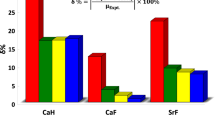Abstract
Anab initio analytical potential energy surface called BW3 for the ClH2 reactive system is presented. The fit of this surface is based on about 1 200ab initio energy points, computed with multi-reference configuration interaction(MRCI) and scaling external correlation (SEC) method and a very large basis set. The precision in the fit is very high. The BW3 surface could reproduce correctly the dissociation energy of H2 and HCl, and the endothermicity of the Cl + H2 abstraction reaction. For the Cl + H2 abstraction reaction, the saddle point of BW3 lies in collinear geometries, and the barrier height is 32.84 kJ/mol; for the H + ClH exchange reaction, the barrier of BW3 is also linear, with a height of 77.40 kJ/mol.
Similar content being viewed by others
References
Thompson, D. L., Suzukava, H. H. Jr., Raff, L. M., A paradox: the thermal rate coefficient for the H+DCl→ HCl+D exchange reaction, J. Chem. Phys., 1975, 62(12): 4727.
Miller, J. C., Gordon, R. J., Kinetics of the Cl-H2 system, II. Abstraction vs exchange in D+HCl, J. Chem. Phys., 1983, 78(6): 3713.
Schwenke, D. W., Tucker, W. S. C., Steckler, R. et al., Global potential-energy surfaces for H2Cl, J. Chem. Phys., 1989, 90(6): 3110.
Allison, T. C., Lynch, G. C., Truhlar, D. G. et al., An improved potential energy surface for the H2Cl system and its use for calculations of rate coefficients and kinetic isotope effects, J. Phys. Chem., 1996, 100(32): 13575.
Mielke, S. L., Allison, T. C., Truhlar, D. G. et al., Quantum mechanical rate coefficients for the Cl+H2 reaction, J. Phys. Chem., 1996, 100(32): 13588.
Lee, S.-H., Liu, K., Exploring the spin-orbit reactivity in the simplest chlorine atom reaction, J. Chem. Phys., 1999, 111(14): 6253.
Lee, S.-H., Lai, L.-H., Liu, K. et al., State-specific excitation function for Cl+H2 (v = 0, j): Effects of spin-orbit and rotational states, J. Chem. Phys., 1999, 110(17): 8229.
Alagia, M., Balucani, N., Cartechini, L. et al., Dynamics of the simplest chlorine atom reaction: An experimental and theoretical study, Science, 1996, 273: 1519.
Skouteris, D., Manolopoulos, D. E., Bian, W. S. et al., The role of van der Waals interactions in the Cl+HD reaction, Science, 1999, 286: 1713.
Bian, W. S., Werner, J., Globalab initio potential energy surfaces for the ClH2 reactive system, J. Chem. Phys., 2000, 112(1): 220.
Manthe, U., Bian, W. S., Werner, J., Quantum mechanical calculation of the thermal rate constant for the H2+Cl→H+HCl reaction, Chem. Phys. Lett., 1999, 313(3–4): 647.
Werner, J., Knowles, P. J., MOLPRO, Stuttgart: Institute of Theoretical Chemistry, 1997.
Aguado, A., Paniagua, M., A new functional form to obtain analytical potentials of triatomic molecules, J. Chem. Phys., 1992, 96(2): 1265.
Huber, K. P., Herzberg, G., Constants of Diatomic Molecules, New York: Van Nostrand, 1979.
Author information
Authors and Affiliations
Corresponding author
Rights and permissions
About this article
Cite this article
Bian, W., Liu, C. & Werner, H.J. A fullyab initio potential energy surface for ClH2 reactive system. Sc. China Ser. B-Chem. 43, 396–404 (2000). https://doi.org/10.1007/BF02969445
Received:
Issue Date:
DOI: https://doi.org/10.1007/BF02969445




